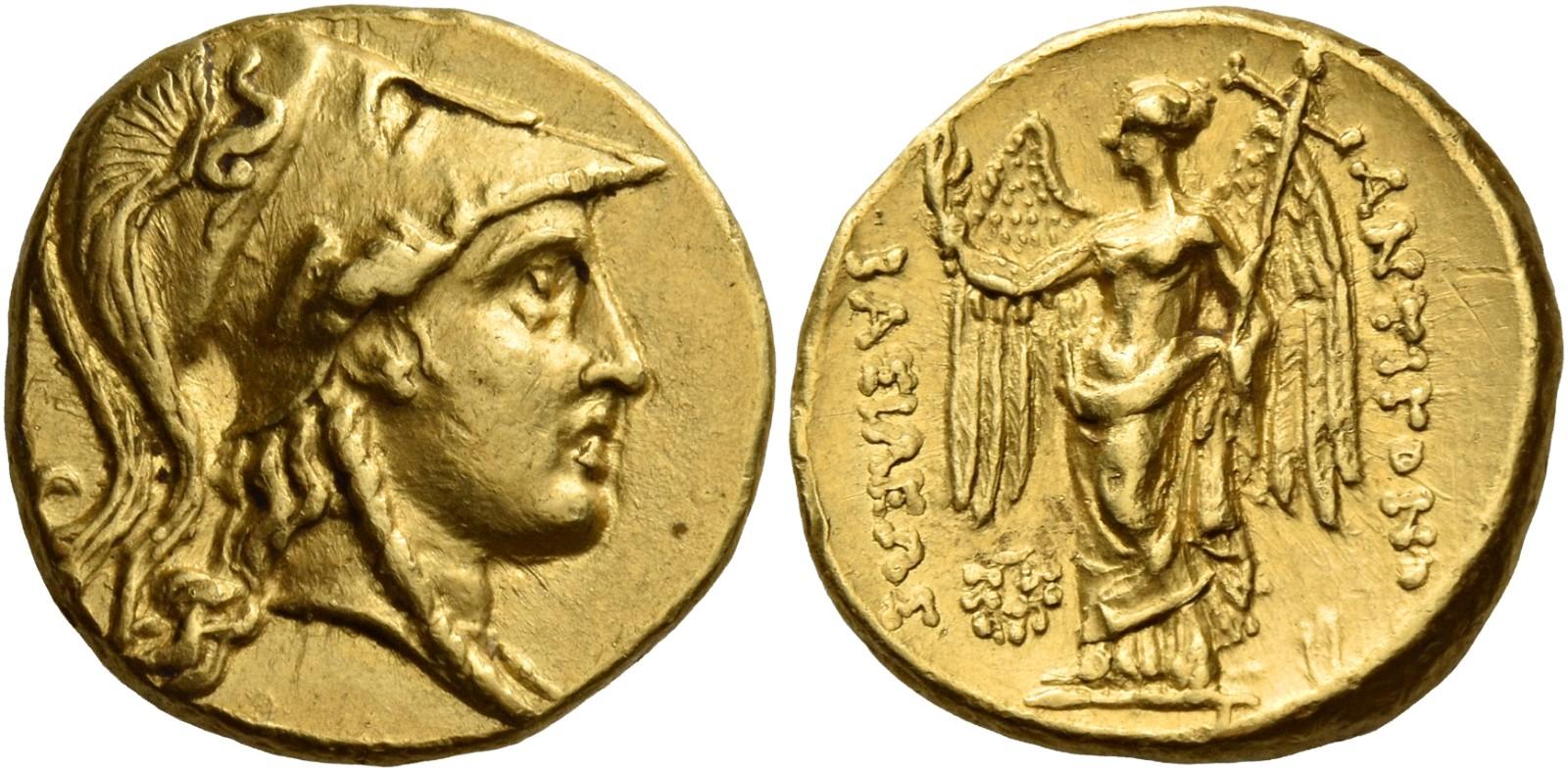Pella (Antigonus gonatas), gold, staters (277-239 BCE)
From SILVER
277 BCE - 239 BCE Gold 39,715 kg
Description
| ObverseInscription or printing placed on the obverse.: | Head of Athena r., wearing Corinthian helmet decorated with coiled snake |
| ReverseInscription or printing placed on the reverse.: | BAΣIΛEΩΣ – ANTIΓONOY (Greek).Nike standing to l., holding stylis in l. hand and aplustre in r., below in the l. inner field, wreath |
Mint and issuing power
| MintIdentifies the place of manufacture or issue of a numismatic object.: | Pella | Ancient regionAncient region.: | Macedon | Modern countryModern country: Greece | AuthorityIdentifies the issuing power. The authority can be "pretended" when the name or the portrait of X is on the coin but he/she was not the issuing power. It can also be "uncertain" when there is no mention of X on the coin but he/she was the issuing power according to the historical sources: | Antigonus II Gonatas (Antigonid king, 277/6-239 BC) |
Chronology
| FromIdentifies the initial date in a range assigned in a numismatic context. | 277 BCE | toIdentifies the final date in a range assigned in a numismatic context.. | 239 BCE | PeriodTime period of the numismatic object.: Hellenistic 323-30 BC |
Physical description
| MetalThe physical material (usually metal) from which an object is made.: | Gold |
Median weightMedian of the weights of numismatic objects (in grams). in grams | 8.60 | DenominationTerm indicating the value of a numismatic object. Examples: tetradrachm, chalkous, denarius.: | stater |
StandardStandard.: | Attic |
Image

S1749 Antigonus Gonatas stater Alexander.jpg [1]
References
| Die study referencePublication of the study: | Panagopoulou 20011Panagopoulou 2001, Panagopoulou 20202Panagopoulou 2020, p. 24 | ||
| Coin series referenceReference to coin series study: | |||
Obverse dies distribution
| FrequencyFrequency of specimen in distribution. ᵖ | Number of obversesNumber of obverse dies. ᵖ (o) | % (o) | Number of coinsNumber of coins. (n) | % (n) | Die nameName(s) of the die(s). |
| 1 | 4 | 80 | 4 | 66.67 | 2, 3, 4, 5 |
| 2 | 1 | 20 | 2 | 33.33 | 1 |
| Total | 5 of 5 | 100 | 6 of 6 | 100 |
Reverse dies distribution
no distribution is available
Quantification
| Number of obversesNumber of obverse dies. ᵖ (o) | 5 | Number of singletons (o1)The number of singleton coins. ᵖ | 4 |
| Number of reverse diesNumber of reverse dies. (r) | 3 | Number of coinsNumber of coins. (n) | 6 |
| Coins per obverse dieNumber of coins per obverse die. (n/o) | 1.2 | Coins per reverse dieNumber of coins per reverse die. (n/r) | 2 |
| Reverse per obverse ratioRatio of obverse dies divided by reverse dies. (r/o) | 0.6 | Percentage of singletons (o1)number of coins (n) divided by the number of singletons (o1) ᵖ | 80 % |
| Original number of dies (O) (Carter 1983 formula)The estimation of the number of coins according to Carter 1983 ᵖ | 23.09 | Coins struck if 20,000 as average productivity per dieCoins made if the average productivity for obverses (according to Carter) is 20,000. ᵖ | 461,800 |
| Original number of dies (O) (Esty 2011 formula)The estimation of the number of coins according to the singleton formula in Esty 2011 ᵖ (O) | 30 | Survival rate if 20,000 as average productivity per dieSurvival rate if average productivity is 20,000. ᵖ | 0.00001 |
| Coverage (o = % of O) (Esty 1984 formula)Esty 1984 - coverage (% of O) ᵖ (o = % of O) | 33.33% | Die productivity if survival rate 1/2,000Average productivity if survival rate is 1/2,000. ᵖ | 519.71 |
| Weight of silver (in kg) if 20,000 coins per die (O = Carter formula)Carter 1983 * Median weight * 20000 (*10 if gold or electrum) ᵖ | 39,715 kg <br /> 39,715 kg | Die productivity if survival rate 1/5,000Average productivity if survival rate is 1/5,000. ᵖ | 1,299.26 |
Remarks
Most likely one single workstation Certainly military Panagopoulou 2001: 5 coins, 5 obv., 5 rev.